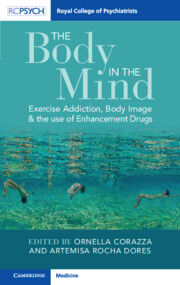Book contents
- The Body in the Mind
- The Body in the Mind
- Copyright page
- Dedication
- Contents
- Figures
- Tables
- Boxes
- Contributors
- Acknowledgements
- Introduction
- Section 1 From Exercise to Addiction: An Introduction to the Phenomenon
- Chapter 1 Exercise Addiction
- Chapter 2 From Exercise to Addiction
- Chapter 3 The COVID-19 Pandemic
- Chapter 4 Excessive Exercise and Image- and Performance-Enhancing Drug Use Among Sports Disciplines, and the Role of Mind–Body Training
- Chapter 5 The Ideal of the Perfect Body
- Chapter 6 Exercise, Fitspiration, and the Role of Social Media
- Chapter 7 Eating Disorders and Over-Exercise
- Chapter 8 Exercise and the Use of Image- and Performance-Enhancing Drugs within the Gym Environment
- Chapter 9 Bodybuilding, Exercise, and Image- and Performance-Enhancing Drug Use during the COVID-19 Pandemic
- Chapter 10 How to Treat Exercise Addiction
- Section 2 Reaching the Extreme with Exercise: A Collection of Clinical Case Studies
- Section 3 Exploring the Motivations Behind Exercise Addiction
- Index
- References
Chapter 1 - Exercise Addiction
Evolution and Challenges for Its Recognition as a Clinical Disorder
from Section 1 - From Exercise to Addiction: An Introduction to the Phenomenon
Published online by Cambridge University Press: 30 March 2023
- The Body in the Mind
- The Body in the Mind
- Copyright page
- Dedication
- Contents
- Figures
- Tables
- Boxes
- Contributors
- Acknowledgements
- Introduction
- Section 1 From Exercise to Addiction: An Introduction to the Phenomenon
- Chapter 1 Exercise Addiction
- Chapter 2 From Exercise to Addiction
- Chapter 3 The COVID-19 Pandemic
- Chapter 4 Excessive Exercise and Image- and Performance-Enhancing Drug Use Among Sports Disciplines, and the Role of Mind–Body Training
- Chapter 5 The Ideal of the Perfect Body
- Chapter 6 Exercise, Fitspiration, and the Role of Social Media
- Chapter 7 Eating Disorders and Over-Exercise
- Chapter 8 Exercise and the Use of Image- and Performance-Enhancing Drugs within the Gym Environment
- Chapter 9 Bodybuilding, Exercise, and Image- and Performance-Enhancing Drug Use during the COVID-19 Pandemic
- Chapter 10 How to Treat Exercise Addiction
- Section 2 Reaching the Extreme with Exercise: A Collection of Clinical Case Studies
- Section 3 Exploring the Motivations Behind Exercise Addiction
- Index
- References
Summary
The potential negative effects of exercise addiction (EA) were first reported over 50 years ago, but it has only recently been formally recognized as a disorder in the leading clinical manuals. The inclusion of exercise behaviour as a potentially addictive behaviour will require greater consensus on how to define this disorder, with diagnostic criteria and course descriptions clearly supported by scientific evidence, and on how to categorize it in relation to other mental disorders. This chapter presents an overview of attempts to identify the defining features of EA, the development of instruments to measure it, estimates of its prevalence, and the main strategies for treating it. The diverse terminology used to describe this disorder reflects both the range of perspectives from which it has been examined, and the different manifestations of EA. The chapter concludes by recognizing that the development and validation of specific diagnostic criteria for EA pose many challenges.
- Type
- Chapter
- Information
- The Body in the MindExercise Addiction, Body Image and the Use of Enhancement Drugs, pp. 1 - 24Publisher: Cambridge University PressPrint publication year: 2023

